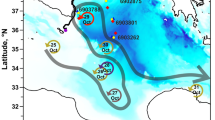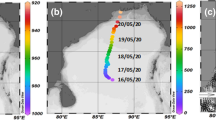Abstract
In recent decades, there has been notable variability in the occurrence, frequency, and intensification of cyclones worldwide, and a significant trend has emerged in the northern Indian Ocean, notably the Arabian Sea. The recent cyclone, Biparjoy, occurred in June 2023 and stands out as a significant event among these occurrences. Through an extensive analysis utilizing available datasets (both in-situ and model-based) along the vertical trajectory of cyclone paths, it has been ascertained that the intensity of cyclones is influenced by the advection of warm saline (referred to as “Spicy”) water originating north of the cyclone’s track. This influx of high-saline waters occurs at various depths, inducing alterations in the vertical water column configuration. Notably, the diffusion of heat overtakes that of salt, resulting in the gradual dispersion of the saline water. These high salinity levels are prevalent at depths ranging from 0 to 300 m, with a pronounced concentration up to 100 m below the surface. The presence of these warm saline waters overlying the colder, fresher waters gives rise to a phenomenon known as “salt fingering” (45o < Tu < 90o), which establishes a stable surface layer predominantly controlled by temperature gradients. This stable surface layer, extending up to approximately 50 m in depth holding a substantial heat, fostering a positive feedback loop that amplifies cyclone intensity. As the spiciness of the Arabian Sea experiences an ascending trend in recent years, the continued extension of saline water advection bears intense implications for upper ocean heat content. This, in turn, creates a favorable environment for the formation and rapid intensification of cyclones.







Similar content being viewed by others
Data availability
The datasets generated during the current study are available from the author on personal request.
References
Albert J, Bhaskaran PK (2020) Ocean heat content and its role in tropical cyclogenesis for the Bay of Bengal basin. Clim Dyn 55:3343–3362. https://doi.org/10.1007/s00382-020-05450-9
Cummings JA (2005) Operational multivariate ocean data assimilation. Quart J Royal Met Soc Part C 131(613):3583–3604
Cummings JA, Smedstad OM (2013) Variational Data Assimilation for the Global Ocean. Data Assimilation for Atmospheric, Oceanic and Hydrologic Applications. Chap 13 II:303–343
Emanuel K (2020) Evidence that hurricanes are getting stronger. Proc Natl Acad Sci 117(24):13194–13195
Emanuel KA (1987) The dependence of hurricane intensity on climate. Nature 326:483–485
Emanuel K, Sundararajan R, Williams J (2008) Hurricanes and global warming: results from downscaling IPCC AR4 simulations. Bull Am Meteorol Soc 89:347–368
Flament P (2002) A state variable for characterizing water masses and their diffusive stability: Spiciness. Prog Oceanogr 54(1–4):493–501
Helber RW, Townsend TL, Barron CN, Dastugue JM, Carnes MR (2013) Validation test report for the Improved Synthetic Ocean Profile (ISOP) system, Part I: Synthetic profile methods and algorithm. Naval Res. Lab. Rep. NRL/MR/7320-13-9364
Jackett DR, McDougall TJ (1985) An oceanographic variable for the characterization of intrusions and water masses. Deep Sea Research Part A. Oceanogr Res Pap 32(10):1195–1207
Knutson TR, Tuleya RE (2004) Impact of CO2-induced warming on simulated hurricane intensity and precipitation: sensitivity to the choice of climate model and convective parameterization. J Clim 17:3477–
Li Y, Wang F (2015) Thermocline spiciness variations in the tropical Indian Ocean observed during 2003–2014. Deep-Sea Res 97:52–66. https://doi.org/10.1016/j.dsr.2014.12.004
Madhu, N. V., Maheswaran, P. A., Jyothibabu, R., Sunil, V., Revichandran, C., Balasubramanian,T., … Nair, K. K. C. (2002). Enhanced biological production off Chennai triggered by October 1999 super cyclone (Orissa). Curr. Sci, 82(12), 1472–1479
Maneesha K, Brahmananda Rao V, Patnaik KVKRK, Franchito SH (2023a) The Intrusion of Spicy Water Favours the intensification of Arabian Sea cyclones. Atmos Ocean 61(2):84–93
Maneesha K, Ratheesh S, Bhaskar TU (2023b) Impact of the upper ocean processes on intensification of cyclone Amphan. J Indian Soc Remote Sens 51(2):289–298
Maneesha K, Prasad VS, Venkateswararao K (2021) Ocean impact on the intensification of cyclone Titli. J Earth Syst Sci 130(3):164
McDougall TJ, Krzysik OA (2015) Spiciness J Mar Res 73(5):141–152. https://doi.org/10.1357/002224015816665589
McPhaden MJ, Foltz GR, Lee T, Murty VSN, Ravichandran M, Veechi GA, Vialard J, Wiggert JD, Yu L (2009) Ocean-atmosphere interactions during cyclone Nargis, Eos Trans. AGU, vol. 90, no. 7, pp. 53–60, Feb.
Murakami H, Vecchi GA, Underwood S (2017) Increasing frequency of extremely severe cyclonic storms over the Arabian Sea. Nat Clim Change 7(12):885–889
Murty VSN, Sarma YVB, Rao DP (1996) Variability of the oceanic Boundary layer characteristics in the northern Bay of Bengal during MONTBLEX-90. In: Proc. Indian Acad. Sci. (Earth Planet Sci.), 105:41–61
Patnaik KVKRK, Maneesha K, Sadhuram Y, Prasad KVSR, Murty R, T. V., Rao B, V (2014) East India Coastal Current induced eddies and their interaction with tropical storms over Bay of Bengal. J Oper Oceanogr 7(1):58–68
Ruddick B (1983) A practical indicator of the stability of the water column to double-diffusive activity. Deep Sea Research Part A Oceanographic Research Papers 30(10):1105–1107
Saha CK (2015) Dynamics of disaster-induced risk in southwestern coastal Bangladesh: an analysis on tropical Cyclone Aila 2009. Nat Hazards 75(1):727–754
Sathyanarayanan A, Köhl A, Stammer D (2021) Ocean Salinity changes in the Global Ocean under global warming conditions. Part I: mechanisms in a strong warming scenario. J Clim 34:8219–8236. https://doi.org/10.1175/JCLI-D-20-0865.1
Schneider N (2004) The response of Tropical Climate to the equatorial emergence of spiciness anomalies. J Clim 17(5):1083–1095
Shay LK, Brewster JK (2010) Oceanic heat content variability in the eastern Pacific Ocean for hurricane intensity forecasting. Mon Weather Rev 138(6):2110–2131
Shcherbina AY, Gregg MC, Alford MH, Harcourt RR (2009) Characterizing thermohaline intrusions in the North Pacific subtropical frontal zone. J Phys Oceanogr 39(11):2735–2756
Singh K, Panda J, Sahoo M, Mohapatra M (2019) Variability in tropical cyclone climatology over North Indian Ocean during the period 1891 to 2015. Asia-Pac J Atmos Sci 55:269–287
Sreenivas Pentakota., and, Gnanaseelan C (2014) Impact of oceanic processes on the life cycle of severe cyclonic storm Jal. IEEE Geosci Remote Sens Lett 11(2):519–523. https://doi.org/10.1109/LGRS.2013.2271512,519-523
Sreenivas P, Vivek S, Seshagiri Rao K (2018) Role of Andaman Sea in the intensification of cyclones over Bay of Bengal, Nat Hazards. 91:1113–1125. https://doi.org/10.1007/s11069-018-3170-x
Turner JS (1967) Salt fingers across a density interface. Deep-Sea Res 14:499–611
Veronis G (2021) On properties of seawater defined by temperature, salinity, and pressure. J Mar Res 79(3):121–147
You Y (2002) A global ocean climatological atlas of the Turner angle: implications for double-diffusion and water-mass structure. Deep Sea Res Part I 49(11):2075–2093
Zhang Y, Du Y, Qu T, Hong Y, Domingues CM, Feng M (2021) Changes in the Subantarctic Mode Water properties and spiciness in the southern Indian Ocean based on argo observations. J Phys Oceanogr 51(7):2203–2221
Acknowledgements
The author acknowledges Asia Pacific Data Research Centre (APDRC), and Copernicus Marine Environment Monitoring Service for providing various datasets used in the present study. The author is thankful to Director CSIR-NIO, Scientist-in-Charge for their support and providing the facilities. This publication is the NIO contribution with no. 7176. Special thanks to the reviewers who substantially contributed to the improvement of the manuscript.
Funding
The author declare that no funds, grants, or other support were received during the preparation of this manuscript.
Author information
Authors and Affiliations
Contributions
K. Maneesha conceived the idea and contributed to the manuscript.
Corresponding author
Ethics declarations
Conflict of interest
The author declare that there is no conflict of interest.
Additional information
Publisher’s Note
Springer Nature remains neutral with regard to jurisdictional claims in published maps and institutional affiliations.
Rights and permissions
Springer Nature or its licensor (e.g. a society or other partner) holds exclusive rights to this article under a publishing agreement with the author(s) or other rightsholder(s); author self-archiving of the accepted manuscript version of this article is solely governed by the terms of such publishing agreement and applicable law.
About this article
Cite this article
Maneesha, K. Effect of “spiciness” on the intensification of cyclones over Arabian Sea - a case study on Biparjoy. Clim Dyn 62, 3955–3963 (2024). https://doi.org/10.1007/s00382-024-07109-1
Received:
Accepted:
Published:
Issue Date:
DOI: https://doi.org/10.1007/s00382-024-07109-1




